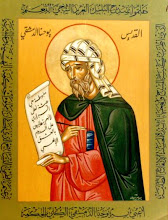The Introductory Prayers
Orthros begins with the Trisagion Prayers. These standard prayers concluding in the Lord’s Prayer are memorized by all Byzantine Christians. The focus is Trinitarian. This affirms that our worship must always center on adoration of the Holy Trinity and therefore always be Christo-centric. The Trisagion Prayers and accompanying hymns and litany also provide the opportunity for the first censing of the Church. Thus, our worship focuses on the Holy Trinity and engages the whole person.
The Six Psalms
While the priest offers the Orthros prayers quietly, the Six Psalms are read. These penitential psalms are read quickly, not intoned or chanted. All stand during the reading, and any candles that have been lit for prayer intentions are extinguished. The silence and attention to psalms allows us to reflect on the universality of the human experience and need for God’s mercy. Thus, there is a spiritual movement from recognition of the majesty of God (as expressed in the introductory prayers) to our awareness that we totally depend on God for our life and salvation.
The Litany of Peace and Troparia of the Day
Having begun with praise of the Holy Trinity and meditation on our need to turn from sin to the Lord, Orthros continues with the Litany of Peace. The petitions of this litany gather up our concerns and needs and place them confidently before the Lord who is generous and loves mankind. The Litany of Peace focuses on universal needs, not personal petitions or selfish requests. It affirms the universality of our cares and rests the entire human condition in God’s hands, trusting in His mercy.
The first of the variable portions of Orthros follows. Verses from the psalms introduce the Troparia of the day. “Troparia” (singular, “troparion”) are poetic theological reflections that focus on the Resurrection, a Feast of our Lord or our Lady, or the particular commemoration of the Church calendar. Troparia are rich in theological insight, and combine adoration of God, the veneration of the saints, and commemoration of events in salvation history. The great mercy of God is a constant theme in troparia.
On a typical Sunday, the Troparion of the Resurrection in the Tone of the week begins the sequence. It is followed by one or more Troparia appointed for the particular day. The final Troparion of the sequence is preceded by “Glory…” and followed by “Now and ever…” in the same tone. The Theotokion of the Resurrection in the same tone as the final Troparion completes the sequence. (Thus, for example, if the final Troparion is in Tone Four, “Glory…” will be chanted in Tone Four, followed by the final Troparion itself, “Now and ever…” in Tone Four, and the Theotokion of the Resurrection in Tone Four.)
The particular selection of troparia for a given celebration places it in the context of the Church year and the calendar year. The cycle of hymns collected in the Octoechos is the basic collection that flow through the life of the Byzantine community. Combined with hymns from the other liturgical books, this hymnody ensures that each celebration of Orthros is a unique opportunity for praise and learning the essential truths of the Christian Faith.
Subscribe to:
Post Comments (Atom)


No comments:
Post a Comment